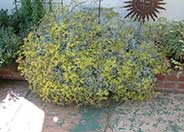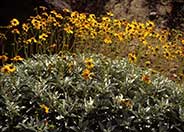
Common name:Conejo Buckwheat
Botanical name:Eriogonum crocatum
Saffron Buckwheat is a compact, low growing perennial 1'-2' high and wide, having white woolly stems and leaves and contrasting yellow flower clusters summer to fall. It tolerates heavy soils if given good drainage and no summer water.-Cornflower Farms

Common name:Brittlebush
Botanical name:Encelia densiflora
This plant will grow 2'-5' high and produces bright yellow flowers that bloom from March to June. It has silvery/gray leaves and brittle branches that have an aromatic resin.

Common name:Woolly Blue Curls
Botanical name:Trichostema lanatum
The Woolly Blue Curls is an evergreen shrub that reaches 3'-5' high. It has an open branching habit and has long stalks of brilliant purple woolly flowers in the spring and summer. This shrub is native to California, is drought tolerant, and attracts hummingbirds. -Cornflower Farms

Common name:Island Bush Poppy
Botanical name:Dendromecon harfordii
An evergreen shrub that grows quickly to 5'-8' tall and 6'-10' wide; the harfordii bears deep yellow poppy flowers to 3" wide with orange stamens. Its heaviest bloom period is in the spring, with some flowers almost all year. The plant requires sun, good drainage, and little or no summer watering. -Monterey Bay Nursery

Common name:Mexican Palo Verde, Jerusalem Thorn
Botanical name:Parkinsonia aculeata
The Mexican Palo Verde has prickly stems. This tree is very fast growing with sparse foliage and very long narrow leaves. Yellow flowers with orange red throats bloom sporadically. It is very messy, thorny, weedy and short-lived. This tree is usually found on limestone soils in areas with moisture but is strongly drought tolerant. It can withstand saline conditions. It can be cold or drought deciduous. It is beautiful in form being light and airy looking, with green bark.
Dealing With Drought
More than half of the water used at your home is for outside purposes. Studies show that on average, half of the water used outdoors is wasted. The leading cause of waste is incorrectly set and poorly managed irrigation controllers. The second biggest cause of wastage is broken irrigation equipment that goes undetected. There are a few basic things you can do to make a big difference in your water use.
Click in the green box for more information
| Designer: | California Western Style |
Photographer: GardenSoft |
Soils and Compost:
Maintain a two to four inch layer of mulch on the soil surface to reduce weeds, infiltrate rain water, and reduce compaction.
Integrated Pest Management:
Remove irrigation water and fertilizer from areas where you don't want weeds to grow.

